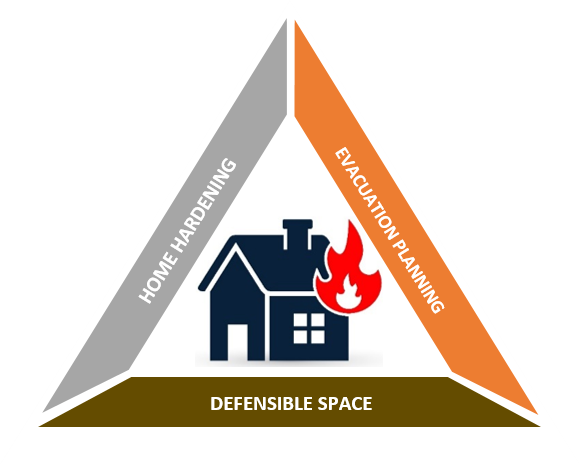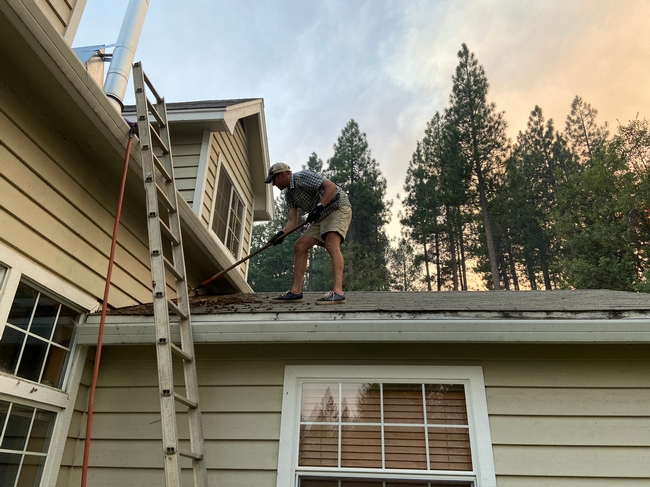Many of us know May for flowers and Mother's Day (hope you didn't forget!), but after last year's widespread and long-lasting fire season, many Californians have come to recognize May as Wildfire Preparedness Month. Our lackluster winter in Northern California underscores the necessity for wildfire preparedness as we embark on our seasonal drought typical of Mediterranean climate summers. Just as many in the mountainous West prepare for winter storms by squirreling away firewood, cleaning rain gutters, and taking down the patio furniture, we also must prepare for summer wildfires in analogous ways: clearing dead leaves and debris from our homes, removing the firewood from the deck, and yes, cleaning those gutters again!
Much of wildfire preparedness centers on residents taking personal responsibility to prepare, and it's the a
- Creating and maintaining defensible space around your home,
- Improving your home's resistance to ignition (a.k.a. “home hardening”)
- Household evacuation planning and preparation.
Wildlife preparedness survey results preview
At the beginning of the 2020 fire season, we asked residents in five northeastern California counties about efforts they were taking to prepare for wildfires and what barriers they perceived in reaching their goals.
- Nearly all indicated that wildfire had impacted their community within the past decade.
- Almost half of the residents indicated their home insurance had been affected in some way (e.g. insurance rate increase, dropped policy) by wildfire risk.
- Most residents were creating and maintaining defensible space on their property by doing the work themselves or paying for it out of their own pocket – very little was grant funded.
- Many homes in rural communities are older, built long before 2008 WUI (wildland urban interface) building standards were put in place. These homes are in need of retrofitting and there is a growing number of residents interested in home hardening.
- There is high participation in community emergency notification systems (e.g. Code Red, Everbridge), but only a minority of residents have an evacuation plan or taken steps to prepare for evacuation. Rural communities, understandably, have a large populations of domestic pets and livestock that require evacuation planning!
While rural northeastern California communities are engaging in wildfire preparedness, time, cost, technical knowledge, and physical capacity were all barriers to creating defensible space and home hardening. So the question becomes, what can we do to increase and enhance our community effectiveness in terms of wildfire preparation?
Get involved and get organized
One of the best places to start is engaging with your community on education and outreach. There are a number of organizations that support this mission, some of the most prolific in California include Fire Safe Councils, Firewise USA® Sites, and Fire Adapted Communities. Fire Safe Councils are local and countywide organizations of interested community members, land management agencies/organizations (e.g. Forest Service), and natural resource and fire management professionals (e.g., volunteer fire district) who are interested in coordinating community-level fuel reduction treatment, education and outreach. You can find more details about local and countywide fire safe councils at the California Fire Safe Council.
Firewise USA® Sites is a nationwide program supported by the National Fire Protection Association (NFPA) designed to empower local neighborhoods and communities to think and act strategically regarding wildfire preparedness. The NFPA Firewise USA® Site program shepherds communities through a process to develop a community wildfire risk assessment, create a community specific action plan of activities to improve wildfire awareness and preparedness, and document the actions community members are taking to mitigate risk.
Fire Adapted Communities and the Fire Adapted community Learning Network provides another context for how all these organizations contribute to wildfire preparedness and offer a forum to connect with communities across the nation that are endeavoring to achieve the same goals: communities that can coexist and be resilient to fire.
Take responsibility and be strategic
The uncertainty in wildfire can be frightening and the task of preparing for wildfire can be overwhelming, but we can all take responsibility and take strategic action – and the accretion of our efforts, and our neighbors' efforts, can contribute to community resistance to wildfire. As the saying goes, Rome was not built in a day. For those of us who have been evacuated or worse, there are always preparedness actions we wished we could have taken sooner or those things that we find ourselves doing at the last minute. May wildfire preparedness month gives us an opportunity before fire season heats up to walk around our yard and home to think about what we'd like to do to prepare. CALFIRE's Ready, Set, Go program has great materials and lists of things to think about.
May also brings great weather to work out in the yard (defensible space) and work on the house (home hardening)! The UCANR Fire in California website has helpful science-based information for homeowners on defensible space, reducing fuels, fire-safe landscaping, and how to prepare your home to be resistant to wildfire. Walk around your home and yard and look at where all your leaves accumulate….those eddies might be the same area an ember might land: Would it burn anything? Pick a project or two that you think is affordable and attainable and make it happen. Very few of us have the money or time to improve everything in a month, but doing what we can still moves the needle on preparedness.
Don't wait to think about evacuation!
Similarly, our UC Cooperative Extension needs assessments and surveys help inform what people are doing, where barriers exist, and easy places to start. Residents responding to surveys help make this happen and these data help the aforementioned partners design relevant programs to help homeowners. For example, we know from our needs assessment that while many people are signed up with an emergency notification system, only a minority have evacuation go-bags, family evacuation/rendezvous plans, important documents, or home inventories in place.
May is a good time to start having those conversations with your family, friends and neighbors. Talk to your family and your kids about what to do if there's a fire when only a portion of the family is at home: Where would you meet? Who would you call? Do you have any neighbors that might need help? What about all those dogs, chickens and horses? Take an evening in May and organize your important documents or make a video inventory of the belongings in your home for insurance documentation. It is best to plan now and plan for an early evacuation during fires!
UC Cooperative Extension advisors and community education specialists across California are committed to fire resiliency and community disaster preparedness. This blog provides a snapshot of the community-based research we conducted last year. UCCE is also working on promoting grazing as a tool to reduce catastrophic fires, reintroducing prescribed fire to reduce fire fuel loads, researching building materials and designs for home survival in wildfire-fire prone areas and much more. Please join us in creating a fire-resilient community by taking actions this May for fire preparedness around your home and creating an evacuation plan with your family.
If you have questions, need help or are looking for technical advisor, please reach out to your local University of California Cooperative Extension office.
